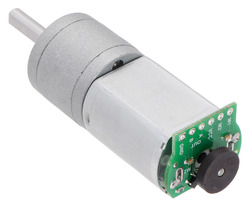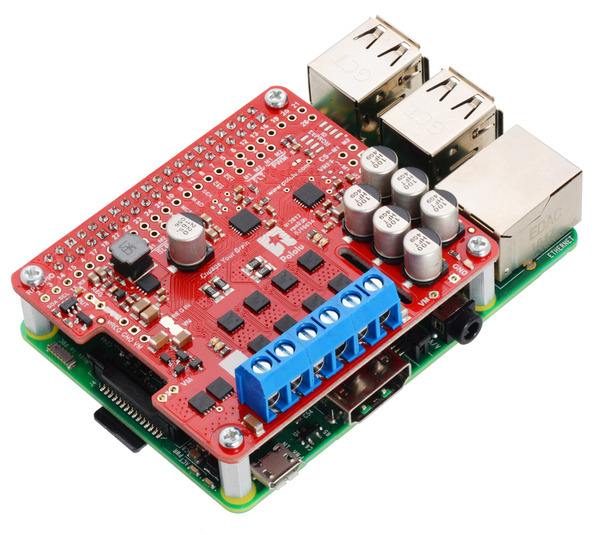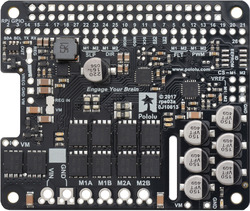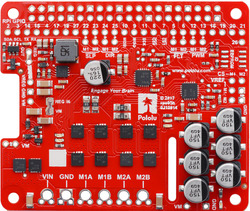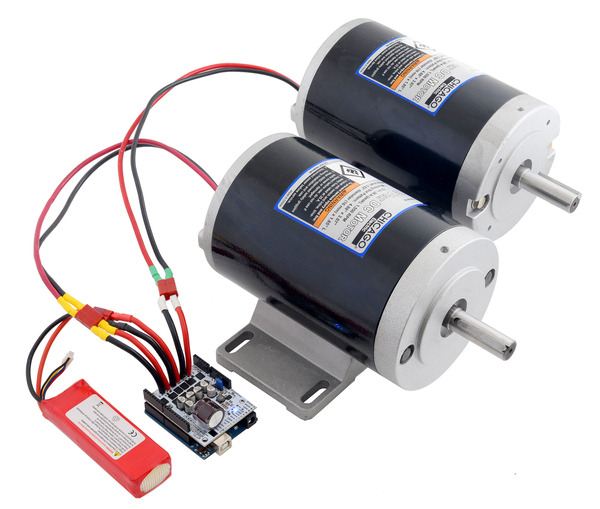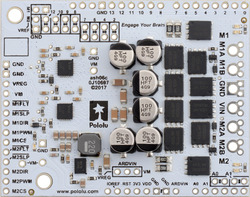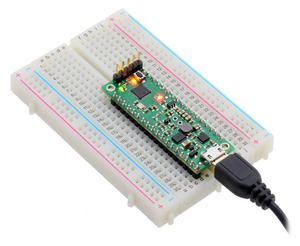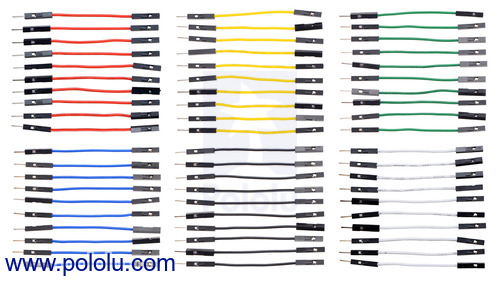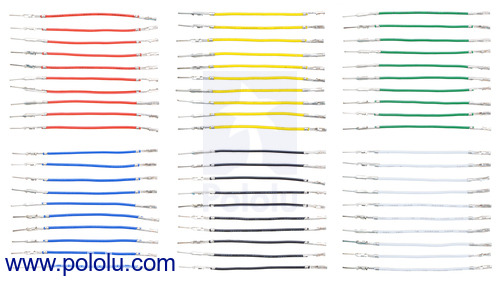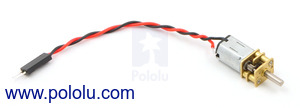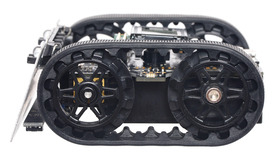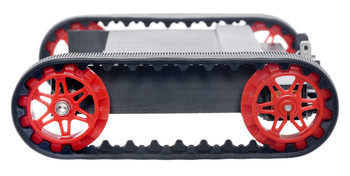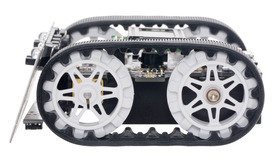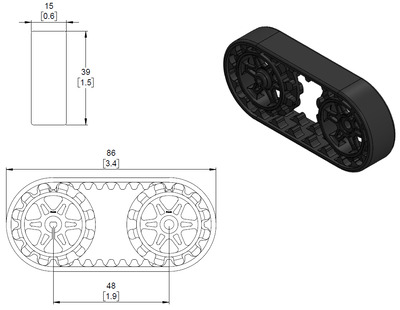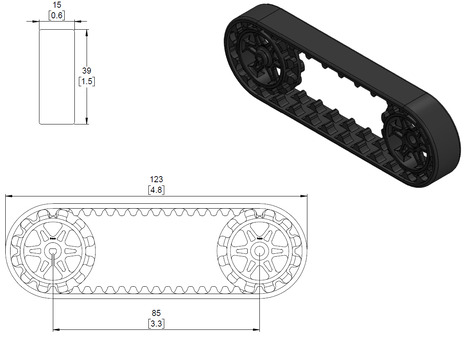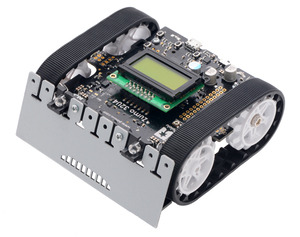Pololu Blog » Posts tagged “new products” »
Posts tagged “new products” (Page 13)
You are currently viewing a selection of posts from the Pololu Blog. You can also view all the posts.
Popular tags: community projects new products raspberry pi arduino more…
Our 20D gearmotors with long-life carbon brushes are now available with extended motor shafts
Last month when we introduced versions of our 20D gearmotors with long-life carbon brushes, we mentioned units with extended motor shafts were in the works. Well, I’m happy to announce that option is now available for both the 12V CB and 6V CB 20D gearmotors, making it possible to use them with encoders like our magnetic encoder kit. The following table shows our full selection of 20D gearmotors, which has now grown to 72 options:
| Rated Voltage |
Brush Type | Stall Current @ Rated Voltage |
No-Load Speed @ Rated Voltage |
Approximate Stall Torque @ Rated Voltage |
 Single-Shaft (Gearbox Only) |
 Dual-Shaft (Gearbox & Motor) |
|---|---|---|---|---|---|---|
| 12 V | long-life carbon (CB) |
1.6 A | 570 RPM | 26 oz-in | 25:1 12V CB | 25:1 12V CB dual shaft |
| 450 RPM | 33 oz-in | 31:1 12V CB | 31:1 12V CB dual shaft | |||
| 225 RPM | 58 oz-in | 63:1 12V CB | 63:1 12V CB dual shaft | |||
| 180 RPM | 75 oz-in | 78:1 12V CB | 78:1 12V CB dual shaft | |||
| 140 RPM | 85 oz-in | 100:1 12V CB | 100:1 12V CB dual shaft | |||
| 110 RPM | 110 oz-in | 125:1 12V CB | 125:1 12V CB dual shaft | |||
| 90 RPM | 130 oz-in | 156:1 12V CB | 156:1 12V CB dual shaft | |||
| 72 RPM | 160 oz-in | 195:1 12V CB | 195:1 12V CB dual shaft | |||
| 57 RPM | 200 oz-in | 250:1 12V CB | 250:1 12V CB dual shaft | |||
| 45 RPM | 250 oz-in | 313:1 12V CB | 313:1 12V CB dual shaft | |||
| 36 RPM | 290 oz-in | 391:1 12V CB | 391:1 12V CB dual shaft | |||
| 29 RPM | 350 oz-in | 488:1 12V CB | 488:1 12V CB dual shaft | |||
| 6 V | long-life carbon (CB) |
2.9 A | 590 RPM | 22 oz-in | 25:1 6V CB | 25:1 6V CB dual shaft |
| 470 RPM | 28 oz-in | 31:1 6V CB | 31:1 6V CB dual shaft | |||
| 230 RPM | 54 oz-in | 63:1 6V CB | 63:1 6V CB dual shaft | |||
| 190 RPM | 62 oz-in | 78:1 6V CB | 78:1 6V CB dual shaft | |||
| 150 RPM | 72 oz-in | 100:1 6V CB | 100:1 6V CB dual shaft | |||
| 120 RPM | 87 oz-in | 125:1 6V CB | 125:1 6V CB dual shaft | |||
| 93 RPM | 110 oz-in | 156:1 6V CB | 156:1 6V CB dual shaft | |||
| 75 RPM | 130 oz-in | 195:1 6V CB | 195:1 6V CB dual shaft | |||
| 60 RPM | 170 oz-in | 250:1 6V CB | 250:1 6V CB dual shaft | |||
| 46 RPM | 220 oz-in | 313:1 6V CB | 313:1 6V CB dual shaft | |||
| 37 RPM | 260 oz-in | 391:1 6V CB | 391:1 6V CB dual shaft | |||
| 30 RPM | 310 oz-in | 488:1 6V CB | 488:1 6V CB dual shaft | |||
| 6 V | precious metal |
2.9 A | 590 RPM | 22 oz-in | 25:1 6V | 25:1 6V dual-shaft |
| 470 RPM | 28 oz-in | 31:1 6V | 31:1 6V dual-shaft | |||
| 230 RPM | 54 oz-in | 63:1 6V | 63:1 6V dual-shaft | |||
| 190 RPM | 62 oz-in | 78:1 6V | 78:1 6V dual-shaft | |||
| 150 RPM | 72 oz-in | 100:1 6V | 100:1 6V dual-shaft | |||
| 120 RPM | 87 oz-in | 125:1 6V | 125:1 6V dual-shaft | |||
| 93 RPM | 110 oz-in | 156:1 6V | 156:1 6V dual-shaft | |||
| 75 RPM | 130 oz-in | 195:1 6V | 195:1 6V dual-shaft | |||
| 60 RPM | 170 oz-in | 250:1 6V | 250:1 6V dual-shaft | |||
| 46 RPM | 220 oz-in | 313:1 6V | 313:1 6V dual-shaft | |||
| 37 RPM | 260 oz-in | 391:1 6V | 391:1 6V dual-shaft | |||
| 30 RPM | 310 oz-in | 488:1 6V | 488:1 6V dual-shaft | |||
Note: Stalling or overloading gearmotors can greatly decrease their lifetimes and even result in immediate damage. In order to avoid damaging the gearbox, we recommend keeping continuously applied loads under 50 oz-in (3.5 kg*cm) for the versions with precious metal brushes and under 70 oz-in (5 kg-cm) for the versions with carbon brushes (the ones with “CB” in the name). Stalls can also result in rapid (potentially on the order of a second) thermal damage to the motor windings and brushes, especially for motors like this that can deliver a lot of power for their size; a general recommendation for brushed DC motors is to limit continuous current to approximately 25% of the stall current.
Now for Raspberry Pi too: Dual G2 High-Power Motor Drivers
As Jan promised yesterday, our new dual motor drivers are now also available as Raspberry Pi expansion boards! The Dual G2 High-Power Motor Drivers for Raspberry Pi feature two discrete MOSFET H-bridges on a board designed to plug directly into a Raspberry Pi (Model B+ or newer), and they also include an integrated 5 V, 2.5 A switching step-down regulator that allows a single power supply to power both the motors and the Raspberry Pi. We provide a Python library for Raspberry Pi to make it easy to get started using the drivers.
|
|
As with the Arduino shield (or standalone) versions, two different PCBs are used for these drivers: the black board has 5×6 mm MOSFETs and the red board has 3×3 mm MOSFETs. Again, each board is available with 30 V or 40 V MOSFETs for a total of four options:
 Dual G2 High- Power Motor Driver 18v22 for Raspberry Pi |
 Dual G2 High- Power Motor Driver 18v18 for Raspberry Pi |
 Dual G2 High- Power Motor Driver 24v18 for Raspberry Pi |
 Dual G2 High- Power Motor Driver 24v14 for Raspberry Pi |
|
|---|---|---|---|---|
| Absolute max input voltage: |
30 V | 36 V* | ||
| Max nominal battery voltage: |
18 V | 28 V | ||
| Max continuous current per channel: |
22 A | 18 A | 18 A | 14 A |
| Default active current- limiting threshold: |
60 A | 50 A | 40 A | |
| Available with connectors installed? |
No | Yes | No | Yes |
* 40 V if regulator is disconnected
Unlike the Arduino, the Raspberry Pi does not have analog inputs, so there isn’t an easy way to do current sensing with these boards. However, the current sensing pins are exposed for advanced users who might want to add an external ADC or otherwise make use of the current sense feedback.
Until now, our motor driver offerings for the Raspberry Pi have been limited to our dual MC33926 and DRV8835 add-on boards, which handle much less current. One of our other favorite integrated motor drivers, the VNH5019, would have been a nice step up in power from the MC33926, but it has one big downside…literally. Its footprint measures around 17 mm by 19 mm, and you can see that on our dual VNH5019 Arduino shield, the two driver ICs take up most of the width of the board:
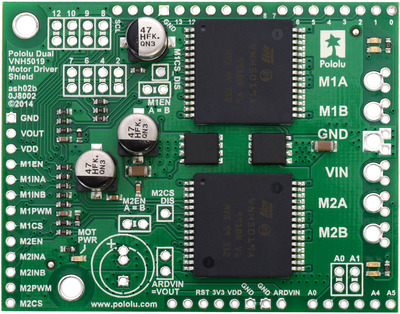 |
Pololu dual VNH5019 motor driver shield for Arduino. |
|---|
We try to make our Raspberry Pi expansion boards conform to the HAT (Hardware Attached on Top) mechanical specification when we can, and that spec recommends including a slot in the middle of the board to accommodate a flex cable plugging into the Raspberry Pi’s camera connector.
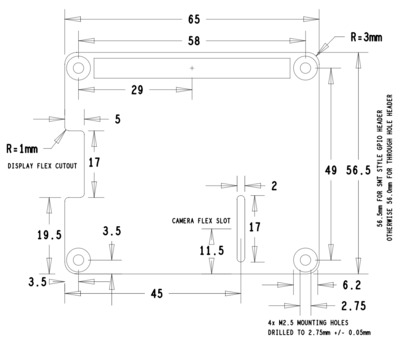 |
Raspberry Pi HAT mechanical specification drawing. |
|---|
Combined with the cutout for the other flex connector, this space limitation means that it would be difficult—if not impossible—to make a VNH5019 motor driver expansion board for the Raspberry Pi that is not annoyingly obstructive. So we are excited that the G2 design, with its discrete MOSFET H-bridges, provided enough layout flexibility for us to create these high-power dual motor driver expansions without making such compromises. We hope that they will open up new possibilities for bigger and more powerful Raspberry Pi robots!
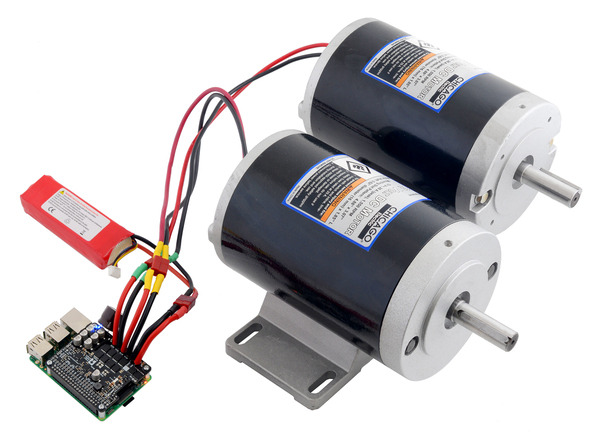 |
New product: Dual G2 High-Power Motor Drivers
We sell a lot of motor drivers, which makes sense since you usually need motors to build robots, and motor drivers tend to be the kind of product you cannot really build yourself on a breadboard. One of our more popular products is the dual VNH5019 shield for the Arduino:
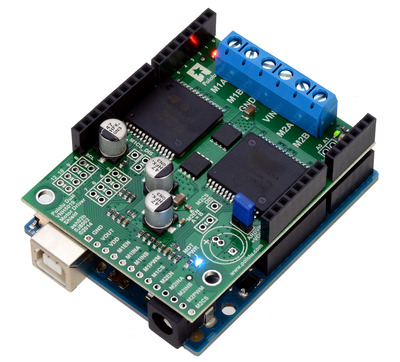 |
Pololu dual VNH5019 motor driver shield, assembled and connected to an Arduino Uno R3. |
|---|
That product is based on ST’s massive VNH5019 motor driver chip, which is a successor to the VNH3SP30 driver we initially started selling back in 2005:
 |
Older version of the High-Current Motor Driver Carrier. |
|---|
When I first heard of the chip (at one of the first LVBots meetings), it seemed like someone must have misremembered the spec since it was inconceivable for a single integrated chip to deliver 30 amps. And to some extent, that was valid—you would have to do a lot of extra thermal management work to get 30 A out of that chip without it overheating. But the chip really could do in excess of 10 A, which was still amazing; the real limitation was in voltage, especially if you tried to use PWM at any moderate frequency. The VNH2SP30 was better about PWM frequency, letting us get to 20 kHz, but it had an upper operating limit of 16 V. The VNH5019 raised this to 24 V, getting us tantalizingly close to the 24V rail many would like to use. The problem is that 24 V is the limit, and we really need to be able to operate higher than that to account for the usual variations in nominally 24V power setups.
As far as I know, there is no integrated circuit that can deliver over ten amps at 24 V nominal (i.e. at least 30 V max); for that kind of power, you need to go to H-bridges with discrete MOSFETs. We have had those as stand-alone products for a while, too. But those still leave you with a lot of wiring to do if you want to drive two motors, which is typically the minimum for a mobile robot. The new product family we just released makes that easy by providing two high-power motor drivers in one Arduino shield-type package:
|
|
As you can see from the pictures, the main difference in these Dual G2 High-Power Motor Driver Shields is in the MOSFETs: the white boards have larger, 5×6mm MOSFETs, and the blue boards have smaller, 3×3mm MOSFETs. These correspond to the two versions of the individual drivers:
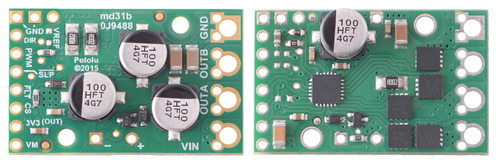 |
Pololu G2 High-Power Motor Driver 24v21 and 24v13. |
|---|
(The higher-power version on the left has the MOSFETs on the back side of the board.) We also offer each board with 30V and 40V MOSFETs, for four total options. The new dual motor drivers perform similarly to our single-channel G2 units, and like the single channel carriers, all of these dual drivers feature current sensing and an adjustable current limit that could be used to detect and protect against stall conditions. These are the individual performance points:
 Dual G2 High- Power Motor Driver 18v22 Shield |
 Dual G2 High- Power Motor Driver 18v18 Shield |
 Dual G2 High- Power Motor Driver 24v18 Shield |
 Dual G2 High- Power Motor Driver 24v14 Shield |
|
|---|---|---|---|---|
| Absolute max input voltage: |
30 V | 40 V | ||
| Max nominal battery voltage: |
18 V | 28 V | ||
| Max continuous current per channel: |
22 A | 18 A | 18 A | 14 A |
| Default active current- limiting threshold: |
60 A | 50 A | 40 A | |
| Current sense output: |
10 mV/A | 20 mV/A | ||
For drivers like these, power (heat) dissipation is generally the limiting factor. The copper area around the MOSFETs on both the white and blue versions of the drivers are about the same, so the lower-current blue units perform better then their smaller single channel G2 counter-parts, while the higher current white drivers do worse than the smaller single channel G2 carriers (which also use four layer PCBs for better performance). The power ratings we provide are the maximums without additional heat sinking or air flow and at room temperature. Please note that the boards will be extremely hot at those maximum currents, and the available current will be lower if the ambient temperature is higher.
Since many Arduino boards do not support higher input voltages, the new dual drivers also incorporate a 1A switching regulator so that a single higher-voltage supply can power the motors and Arduino. We have an Arduino library to help you get up and running quickly. And for those who want to use the board without an Arduino, all of the motor control connections are also brought out to a row of 0.1″ headers on one side of the board.
(And for those of you wanting to use this kind of driver with a Raspberry Pi, we have a Raspberry Pi HAT form-factor version coming soon!)
New product: P-Star 45K50 Mini SV
I am excited to announce our new product, the Pololu P-Star 45K50 Mini SV, which is the second member of our P-Star family of programmable controllers based on the PIC18 microcontrollers from Microchip. The P-Star 45K50 Mini SV features a user-programmable PIC18F45K50 microcontroller (32 KB of flash, 2 KB of RAM, full-speed USB), a USB bootloader, and a switching step-down regulator that allows it to be powered from 5 V to 36 V.
The P-Star 45K50 Mini SV is very similar to the smaller P-Star 25K50 Micro, but is bigger and better, with 11 more I/O pins (for a total of 30), a more capable 5 V regulator, and several other additional features. The table below lists the main differences between the two P-Stars:
 |
P-Star 25K50 Micro (top) and P-Star 45K50 Mini SV (bottom). |
|---|
 |
 | |
| P-Star 25K50 Micro | P-Star 45K50 Mini SV | |
|---|---|---|
| Microcontroller: | PIC18F25K50 | PIC18F45K50 |
| User I/O lines: | 19 | 30 |
| Analog inputs: | 14 | 25 |
| Reset button: |  |
|
| Operating voltage: | 5.5 V to 15 V | 5 V to 36 V |
| Regulator type: | linear | switching step-down |
| Regulated current:(1) | 100 mA | 500 mA |
| Auxiliary 3.3 V regulator: |  |
|
| Dimensions: | 1″ × 0.6″ | 2.0″ × 0.7″ |
1 These values are rough approximations for comparison purposes. Available current depends on input voltage, current consumed by the board, ambient conditions, and regulator topology.
Although we have been using PIC microcontrollers since our very first product, these two P-Stars are our first products where the PIC microcontroller can be programmed by the user. You can program the P-Star in C or assembly with the MPLAB X IDE, or you can use Microchip’s new online IDE, MPLAB Xpress. The P-Star User’s Guide has instructions for getting started with those environments.
You can load programs onto the P-Star via its proprietary USB bootloader using our open source software that is available for Windows, Linux, and Mac. The bootloader uses 8 KB of flash memory, leaving 24 KB for the user. Alternatively, an ICSP programmer can erase the bootloader and access the full 32 KB of program memory. (Since the bootloader is not recoverable, we recommend this option only for those who are comfortable programming exclusively with an external programmer.)
Both P-Star boards feature a precision 16 MHz crystal, a USB Micro-B connector, and three user-controllable LEDs. A voltage regulator and power selection circuit allow the board to be powered from either USB or an external voltage source.
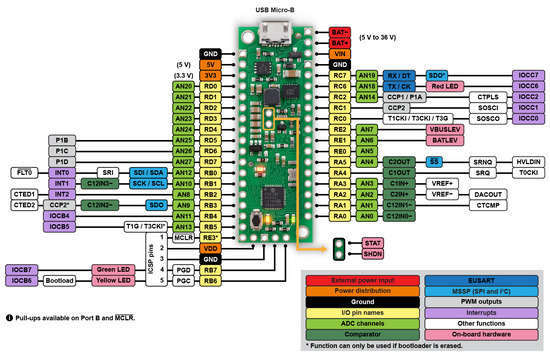 |
P-Star 45K50 Mini SV pinout diagram. |
|---|
Compared to the popular ATmega32U4 microcontroller, the PIC18F25K50 and PIC18F45K50 have nearly the same performance and memory capacity, but these PICs also have some compelling features that are missing on the AVR. For example, they use the PIC18 architecture, which has two interrupt priority levels: interrupts can be assigned to either level, and a high-priority interrupt routine can run during a low-priority one. This powerful feature is what enables our Maestro servo controllers to generate precise servo signals while still using low-priority interrupts to assist with serial communication and other tasks. Unlike the ATmega32U4, these PICs can operate at full speed down to 2.7 V (though the brown-out reset on the P-Star is activated at 2.85 V by default).
|
|
The PIC18F25K50 and PIC18F45K50 also feature a 5-bit digital-to-analog converter (DAC), which is a handy feature not available on many 8-bit microcontrollers. We use that DAC to set the stepper motor current limit on our Tic stepper controllers, where the PIC18F25K50 serves as the main processor.
 |
A 3 kHz triangle wave generated by the 5-bit digital-to-analog converter (DAC) on the P-Star 25K50 Micro. |
|---|
For more information, check out the P-Star 45K50 Mini SV page.
New product: Tic T834 USB Multi-Interface Stepper Motor Controller
I am excited to announce our new product, the Tic T834 USB Multi-Interface Stepper Motor Controller. The Tic T834 is the second member of the Tic family of USB stepper motor controllers. It incorporates a TI DRV8834 driver, can operate from 2.5 V to 10.8 V, and can deliver up to approximately 1.5 A per phase without a heat sink or forced air flow.
Like the Tic T825, the Tic T834 makes basic speed or position control of a stepper motor easy, with support for six high-level control interfaces:
- USB for direct connection to a computer
- TTL serial operating at 5 V for use with a microcontroller
- I²C for use with a microcontroller
- RC hobby servo pulses for use in an RC system
- Analog voltage for use with a potentiometer or analog joystick
- Quadrature encoder input for use with a rotary encoder dial, allowing full rotation without limits (not for position feedback)
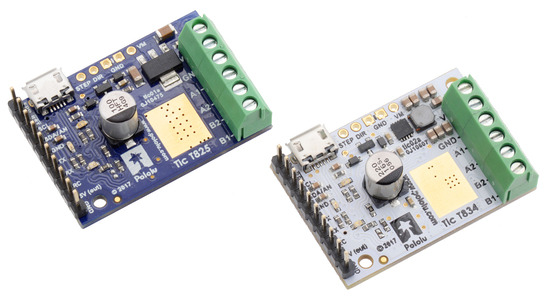 |
Tic T825 and T834 USB Multi-Interface Stepper Motor Controllers. |
|---|
The Tic T834 is available with connectors soldered in or without connectors soldered in.
New 20D gearmotors available with 12 V windings and with long-life carbon brushes
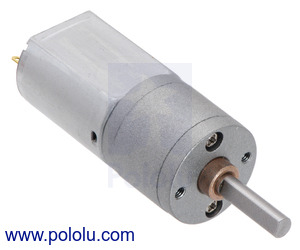 |
We love motors here at Pololu, and we are committed to offering you the best selection so that you can find just the right drive solution for your project. Our latest efforts have gone into expanding our selection of 20D gearmotors to include 12 V versions, which have approximately the same performance at 12 V as our 6 V versions do at 6 V, just with half the current draw. This in turn enables the use of lower-current (and typically lower-cost) motor drivers in applications with access to higher voltages.
Additionally, we noticed that our original 6 V versions do not last as long as we would like in some applications, so we made these new 12 V versions with long-life carbon brushes instead of precious metal brushes, and we released new versions of our 6 V motors with long-life carbon brushes as well. These versions have “CB” in their names, and they can be differentiated from versions with precious metal brushes by their copper-colored terminals.
 |
 |
20D mm metal gearmotor precious metal brushes (left) next to 20D 6V CB and 12V CB long-life carbon brushes. |
|---|
Please note that making the brushes more robust can just move the failure point to the windings or gears if you try to push the motors too hard, but if you use them around their nominal voltages and keep the continuous load low (under around 20% of the stall torque or 1 kg-cm, whichever is lower), the carbon brushes allow the motors to last several times longer than versions with precious metal brushes.
Changing the brushes does affect the performance in ways beyond lifetime (e.g. the starting voltage is generally a little higher with the carbon brushes), so we are continuing to offer precious metal versions of our 6 V motors for now, but we might phase those out in the future. Please contact us or post a comment below if continued availability of the precious metal versions is important to you.
Currently, only the 6V versions with precious metal brushes are available with a rear motor shaft that can be used to add an encoder, like our magnetic encoder for 20D mm metal gearmotors, but the 6V CB and 12V CB motors should be available with this rear shaft option by the end of November.
With the addition of these new units, our selection of 20D gearmotors now spans nearly fifty options:
| Rated Voltage |
Brush Type | Stall Current @ Rated Voltage |
No-Load Speed @ Rated Voltage |
Approximate Stall Torque @ Rated Voltage |
 Single-Shaft (Gearbox Only) |
 Dual-Shaft (Gearbox & Motor) |
|---|---|---|---|---|---|---|
| 12 V | long-life carbon (CB) |
1.6 A | 570 RPM | 26 oz-in | 25:1 12V CB | |
| 450 RPM | 33 oz-in | 31:1 12V CB | ||||
| 225 RPM | 58 oz-in | 63:1 12V CB | ||||
| 180 RPM | 75 oz-in | 78:1 12V CB | ||||
| 140 RPM | 85 oz-in | 100:1 12V CB | ||||
| 110 RPM | 110 oz-in | 125:1 12V CB | ||||
| 90 RPM | 130 oz-in | 156:1 12V CB | ||||
| 72 RPM | 160 oz-in | 195:1 12V CB | ||||
| 57 RPM | 200 oz-in | 250:1 12V CB | ||||
| 45 RPM | 250 oz-in | 313:1 12V CB | ||||
| 36 RPM | 290 oz-in | 391:1 12V CB | ||||
| 29 RPM | 350 oz-in | 488:1 12V CB | ||||
| 6 V | long-life carbon (CB) |
2.9 A | 590 RPM | 22 oz-in | 25:1 6V CB | |
| 470 RPM | 28 oz-in | 31:1 6V CB | ||||
| 230 RPM | 54 oz-in | 63:1 6V CB | ||||
| 190 RPM | 62 oz-in | 78:1 6V CB | ||||
| 150 RPM | 72 oz-in | 100:1 6V CB | ||||
| 120 RPM | 87 oz-in | 125:1 6V CB | ||||
| 93 RPM | 110 oz-in | 156:1 6V CB | ||||
| 75 RPM | 130 oz-in | 195:1 6V CB | ||||
| 60 RPM | 170 oz-in | 250:1 6V CB | ||||
| 46 RPM | 220 oz-in | 313:1 6V CB | ||||
| 37 RPM | 260 oz-in | 391:1 6V CB | ||||
| 30 RPM | 310 oz-in | 488:1 6V CB | ||||
| 6 V | precious metal |
2.9 A | 590 RPM | 22 oz-in | 25:1 6V | 25:1 6V dual-shaft |
| 470 RPM | 28 oz-in | 31:1 6V | 31:1 6V dual-shaft | |||
| 230 RPM | 54 oz-in | 63:1 6V | 63:1 6V dual-shaft | |||
| 190 RPM | 62 oz-in | 78:1 6V | 78:1 6V dual-shaft | |||
| 150 RPM | 72 oz-in | 100:1 6V | 100:1 6V dual-shaft | |||
| 120 RPM | 87 oz-in | 125:1 6V | 125:1 6V dual-shaft | |||
| 93 RPM | 110 oz-in | 156:1 6V | 156:1 6V dual-shaft | |||
| 75 RPM | 130 oz-in | 195:1 6V | 195:1 6V dual-shaft | |||
| 60 RPM | 170 oz-in | 250:1 6V | 250:1 6V dual-shaft | |||
| 46 RPM | 220 oz-in | 313:1 6V | 313:1 6V dual-shaft | |||
| 37 RPM | 260 oz-in | 391:1 6V | 391:1 6V dual-shaft | |||
| 30 RPM | 310 oz-in | 488:1 6V | 488:1 6V dual-shaft | |||
Note: Stalling or overloading gearmotors can greatly decrease their lifetimes and even result in immediate damage. In order to avoid damaging the gearbox, we recommend keeping continuously applied loads under 50 oz-in (3.5 kg*cm) for the versions with precious metal brushes and under 70 oz-in (5 kg-cm) for the versions with carbon brushes (the ones with “CB” in the name). Stalls can also result in rapid (potentially on the order of a second) thermal damage to the motor windings and brushes, especially for motors like this that can deliver a lot of power for their size; a general recommendation for brushed DC motors is to limit continuous current to approximately 25% of the stall current.
Parallax Boe-Bot Robot Kit - USB
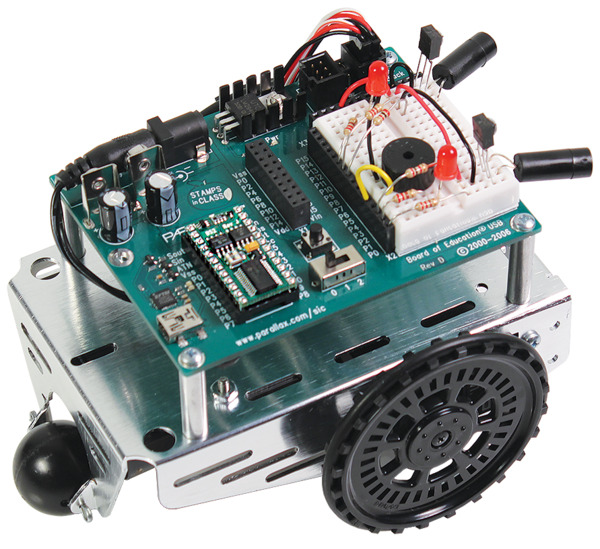 |
We are now carrying the Parallax Boe-Bot Robot Kit - USB, which incorporates a USB-to-serial adapter into the board, so it does not require a separate serial adapter.
The Boe-Bot Robot Kit is an educational kit complete with parts and a textbook for building and programming your own robot. No previous robotics, electronics, or programming experience is required; the kit does not require soldering.
Free Circuit Cellar magazine October 2017
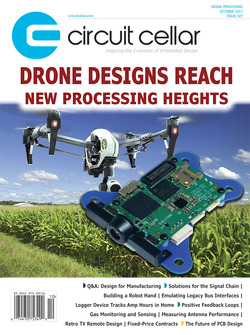 |
Get a FREE copy of Circuit Cellar magazine’s October 2017 issue issue with your order, while supplies last. To get your free issue, enter the coupon code CIRCUIT1017 to your shopping cart, or click the link. The magazine will add 6 ounces to your order weight when calculating your shipping options.
For back issues and more information, see our free Circuit Cellar magazine offers.
1″ (2.5 cm) and 2″ (5 cm) premium jumper wires and wires with pre-crimped terminals
|
|
Our popular premium jumper wires and wires with pre-crimped terminals are a convenient way to make quick, neat connections to 0.1″ (2.54 mm) connectors and solderless breadboards, and they are now available in shorter 1″ and 2″ lengths. Each new length is available in three gender combinations (female-female, male-female, and male-male) and seven color combinations:
- black 10-pack
- red 10-pack
- yellow 10-pack
- green 10-pack
- blue 10-pack
- white 10-pack
- multi-color 60-pack (10 each of all six colors)
Our wires with pre-crimped terminals work with our 0.1″ crimp connector housings to make custom cables with the pin arrangement of your choosing. You can easily make cable harnesses or assemblies that branch from one connector on one side to multiple connectors on the other, and you can also cut off one pre-crimped end and solder the wires directly to components to make swapping connections easy:
|
|
The premium jumper wires are just wires with pre-crimped terminals that have 1×1 crimp connector housings already installed over the crimp pins.
You can use the following selection boxes to get to a specific pack of premium jumper wires:
Alternatives available with variations in these parameter(s): gender length color Select variant…
and you can use the following selection boxes to get to a specific pack of wires with pre-crimped terminals:
Alternatives available with variations in these parameter(s): gender length color Select variant…
New track sets and colorful Zumo sprockets
|
|
|
 |
Pololu 22T Track Set – Red. |
|---|
We have replaced our original Pololu track sets with new versions featuring our newer style of spoked Zumo sprockets. The sprockets are available in three colors, and like our original sets, we have two different track lengths to choose from:
- 22T tracks with black sprockets
- 22T tracks with red sprockets
- 22T tracks with white sprockets
- 30T tracks with black sprockets
- 30T tracks with red sprockets
- 30T tracks with white sprockets
Each track is made of a single piece of flexible silicone, and the drive sprockets are designed to work with 3mm D-shafts, such as those on our micro metal gearmotors and most of our mini plastic gearmotors.
|
|
Additionally, we are offering sprockets by themselves (without tracks or fasteners) for use as replacements for the black sprockets included with our Zumo robots: you can use the red sprockets to add a splash of color, and you can use the white sprockets for painting (or just leave them white!).
|
|


